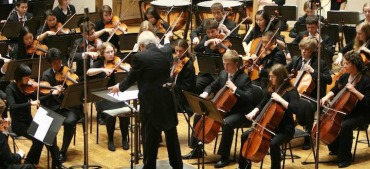The Well-Tempered Ear
Classical music: Did Beethoven borrow from Beethoven? And how do you think the Madison Symphony Orchestra did with Beethoven’s Ninth? Plus, the Wisconsin Youth Symphony Orchestras (WYSO) finish up their spring concerts this weekend. | May 15, 2015
REMINDER: This weekend the Wisconsin Youth Symphony Orchestras (WYSO) finish up their spring concerts at Mills Hall and Overture Hall, where the music students will perform a Side-by-Side concert with the professional players of the Wisconsin Chamber Orchestra.
Here is a link to more information and details:
By Jacob Stockinger
Well, you have to hand it to music director and conductor John DeMain as well as the orchestra players, the chorus members and the guest soloists: The Madison Symphony Orchestra (below, in a photo by Greg Anderson) sure knows how to finish up a season with a bang.
A very Big Bang.
Last weekend in Overture Hall, they closed the current season with a stratospheric performance of Beethoven’s Ninth.
Sure, all parties — especially concertmaster Naha Greenholtz (below) — also did a terrific job in performing Leonard Bernstein’s violin concerto-like “Serenade” (after Plato’s “Symposium”), which preceded the iconic Beethoven symphony.
But it was the Beethoven symphony that grabbed everyone’s ears and didn’t let go, earning a well-deserved and instant standing ovation.
This was Beethoven at his exciting best.
All the musicians played tightly and DeMain (below, in a photo by Prasad) managed to make the old radical piece sound radically new, with a driving rawness and roughness (lots of loud and highly accented percussion) coupled with flawless precision and great balancing of the winds and strings as well as the brass.
This interpretation was both dramatic and transparent in a way that both thrilled you and helped you to understand the music and its structure.
A couple of years ago I remarked that DeMain – who came here from the Houston Grand Opera as primarily an opera conductor – had developed into a great Brahms interpreter.
Now I can say the same thing about his having become an outstanding Beethovenian.
But I did have one question:
Am I the only one who hears the slow movement of Beethoven’s early “Pathétique” piano sonata in the opening of the slow movement of his Ninth Symphony?
Listen for yourself and decide by using these YouTube videos:
First, here is the Pathétique’s slow movement, played by Daniel Barenboim, that has been used as a theme song by many musicians including Karl Haas:
And now here is the slow movement, also with Daniel Barenboim conducting the West-Eastern Divan Orchestra made up of Israeli and Palestinian students, of the Ninth Symphony:
Maybe I am hearing things that aren’t there.
Or maybe musicologists have long established the similarity between the early and the late work as fact -– though I cannot recall having seen it mentioned.
What do you think of the comparison?
Can you think of other pieces that sound as if they were twins separated at birth? Leave names – and maybe a YouTube link – in the COMMENTS section.
And what did you think of the final concert by the Madison Symphony Orchestra?
The Ear wants to hear.
Tags: alto, Arts, bass, Beethoven, brass, chamber orchestra, choral music, Classical music, concertmaster, concerto, conductor, Daniel Barenboim, Jacob Stockinger, Johannes Brahms, John DeMain, Karl Haas, Leonard Bernstein, Ludwig van Beethoven, Madison, Madison Symphony Orchestra, Music, Orchestra, Overture Center, Pathetique Sonata, percussion, Piano, Plato, Platonic dialogue, Serenade, Sonata, soprano, strings, Symposium, tenor, United States, University of Wisconsin-Madison School of Music, University of Wisconsin–Madison, Violin, vocal music, West-Eastern Divan Orchestra, winds, Wisconsin, Wisconsin Chamber Orchestra, Wisconsin Youth Symphony Orchestras, WYSO, YouTube
7 Comments »
Leave a reply to Daniel Polowetzky Cancel reply
This site uses Akismet to reduce spam. Learn how your comment data is processed.
- May 2024
- April 2024
- March 2024
- February 2024
- January 2024
- December 2023
- November 2023
- October 2023
- September 2023
- August 2023
- July 2023
- June 2023
- May 2023
- April 2023
- March 2023
- February 2023
- January 2023
- December 2022
- October 2022
- September 2022
- June 2022
- May 2022
- April 2022
- March 2022
- July 2021
- June 2021
- May 2021
- April 2021
- March 2021
- February 2021
- January 2021
- December 2020
- November 2020
- October 2020
- September 2020
- August 2020
- July 2020
- June 2020
- May 2020
- April 2020
- March 2020
- February 2020
- January 2020
- December 2019
- November 2019
- October 2019
- September 2019
- August 2019
- July 2019
- June 2019
- May 2019
- April 2019
- March 2019
- February 2019
- January 2019
- December 2018
- November 2018
- October 2018
- September 2018
- August 2018
- July 2018
- June 2018
- May 2018
- April 2018
- March 2018
- February 2018
- January 2018
- December 2017
- November 2017
- October 2017
- September 2017
- August 2017
- July 2017
- June 2017
- May 2017
- April 2017
- March 2017
- February 2017
- January 2017
- December 2016
- November 2016
- October 2016
- September 2016
- August 2016
- July 2016
- June 2016
- May 2016
- April 2016
- March 2016
- February 2016
- January 2016
- December 2015
- November 2015
- October 2015
- September 2015
- August 2015
- July 2015
- June 2015
- May 2015
- April 2015
- March 2015
- February 2015
- January 2015
- December 2014
- November 2014
- October 2014
- September 2014
- August 2014
- July 2014
- June 2014
- May 2014
- April 2014
- March 2014
- February 2014
- January 2014
- December 2013
- November 2013
- October 2013
- September 2013
- August 2013
- July 2013
- June 2013
- May 2013
- April 2013
- March 2013
- February 2013
- January 2013
- December 2012
- November 2012
- October 2012
- September 2012
- August 2012
- July 2012
- June 2012
- May 2012
- April 2012
- March 2012
- February 2012
- January 2012
- December 2011
- November 2011
- October 2011
- September 2011
- August 2011
- July 2011
- June 2011
- May 2011
- April 2011
- March 2011
- February 2011
- January 2011
- December 2010
- November 2010
- October 2010
- September 2010
- August 2010
- July 2010
- June 2010
- May 2010
- April 2010
- March 2010
- February 2010
- January 2010
- December 2009
- November 2009
- October 2009
- September 2009
- August 2009
Archives
- 2,490,573 hits
Blog Stats
- Beethoven’s Ninth turns 200 today May 7, 2024
- Pianist Yuja Wang’s new ‘Vienna Recital’ is another triumph May 4, 2024
- Gramophone names the 50 best classical recordings of 2024 — so far May 2, 2024
- What classical music is good for studying, reading and writing? April 30, 2024
- Meet and hear piano phenom Yunchan Lim April 24, 2024
Recent Posts
Recent Comments
| welltemperedear on Beethoven’s Ninth turns 200… | |
| Robert Graebner on Beethoven’s Ninth turns 200… | |
| bevaconme on Pianist Yuja Wang’s new ‘Vienn… | |
| bevaconme on How did pianist Yuja Wang’s he… | |
| welltemperedear on Classical music plus tips for… |
Tags
#BlogPost #BlogPosting #ChamberMusic #FacebookPost #FacebookPosting #MeadWitterSchoolofMusic #TheEar #UniversityofWisconsin-Madison #YouTubevideo Arts audience Bach Baroque Beethoven blog Cello Chamber music choral music Classical music Compact Disc composer Concert concerto conductor Early music Facebook forward Franz Schubert George Frideric Handel Jacob Stockinger Johannes Brahms Johann Sebastian Bach John DeMain like link Ludwig van Beethoven Madison Madison Opera Madison Symphony Orchestra Mead Witter School of Music Mozart Music New Music New York City NPR opera Orchestra Overture Center performer Pianist Piano post posting program share singer Sonata song soprano String quartet Student symphony tag The Ear United States University of Wisconsin-Madison School of Music University of Wisconsin–Madison Viola Violin vocal music Wisconsin Wisconsin Chamber Orchestra wisconsin public radio Wolfgang Amadeus Mozart YouTube



The Pathetique’s slow movement IS a lot like the slow movement of the 9th symphony. You should try playing them at the same time! Even when the Pathetique’s a minute behind their melodies still seem to sound a lot alike. I noticed that Clementi’s Sonatina in C Major Op. 36 No. 3 Movement 1 sounds SO MUCH like Mozart’s Sonatina in C Major Movement 1 K 330. It literally sounds like one of the composers copied the other line by line! I don’t know which one did because I tried to find out when Clementi composed his sonatina but I couldn’t find the information online anywhere. I also noticed that it seems like Clementi mixed all of his former Sonatinas in Op. 36 with some new elements in Sonatina in G Major Op. 36 No. 5 First movement, and in Sonatina in D Major Op. 36 No. 6 it sounds even more like he mixed all of his former Sonatinas in Op. 36 with some new elements.
LikeLike
Comment by fifiandlulucrew — May 17, 2015 @ 8:12 am
Beethoven, not as much. But he did write the Eroica Variations for piano and the Chorale Fantasia that pre-dated the 9th Symphony.
LikeLike
Comment by Daniel Polowetzky — May 15, 2015 @ 8:41 am
Daniel,
You are right. And it goes further. I think the theme of the Eroica variations for piano came from The Creatures of Prometheus Overture and was also used as a main theme in the Symphony No. 3 “Eroica.” But the transcribing or re-scoring of pieces seems historically much more common in the earlier eras, especially the Baroque age.
LikeLike
Comment by welltemperedear — May 15, 2015 @ 9:20 am
Many composers do recycle their own works. Handel also did it often. But I don’t think Beethoven did it a lot.
LikeLike
Comment by welltemperedear — May 15, 2015 @ 8:34 am
The borrowing is obvious and well known.
LikeLike
Comment by Daniel Polowetzky — May 15, 2015 @ 7:35 am
Thank you for writing and replying.
I will take your word for it being well known. But I don’t recall seeing it elsewhere and I also just spoke to someone who is playing and studying the slow movement of the Pathetique but who didn’t hear the parallel to the slow movement of the Ninth.
LikeLike
Comment by welltemperedear — May 15, 2015 @ 7:56 am
Bach arranged his compositions for different ensembles. Some of his harpsichord concertos were originally for violin.
He did the same for chorales some of which occurred in cantatas and other settings.
LikeLike
Comment by Daniel Polowetzky — May 15, 2015 @ 8:13 am